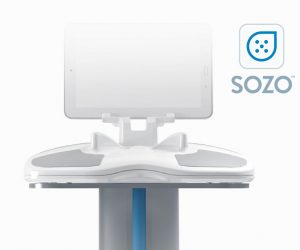SERVICES
CONSULTATIONS
Allow up to 90 minutes for an Initial Consultation, and 60 minutes to 2 hours for subsequent appointments, dependent on the complexity of the case. A full medical history and physical examination is completed during the initial consultation. Goal setting is also an integral element of consultations.
EARLY DETECTION
 The SOZO by Impedimed is a bioimpedance spectroscopy (BIS) device designed to aid in the assessment of bilateral lymphoedema in arms and legs. This device provides a rapid, non-invasive measurement designed to monitor the fluid content in the limbs of people who suffer from, or are at risk of, lymphoedema. The instrument also enables long-term patient monitoring and provides reports to support clinical and research practices.
The SOZO by Impedimed is a bioimpedance spectroscopy (BIS) device designed to aid in the assessment of bilateral lymphoedema in arms and legs. This device provides a rapid, non-invasive measurement designed to monitor the fluid content in the limbs of people who suffer from, or are at risk of, lymphoedema. The instrument also enables long-term patient monitoring and provides reports to support clinical and research practices.
BODY COMPOSITION TISSUE ANALYSIS USING BIOIMPEDENCE TECHNOLOGY
 A SOZO reading provides a detailed and individualised assessment of a patient’s extracellular fluid, intracellular fluid and total body water through bioimpedance spectroscopy in less than 30 seconds.
A SOZO reading provides a detailed and individualised assessment of a patient’s extracellular fluid, intracellular fluid and total body water through bioimpedance spectroscopy in less than 30 seconds.
A single, powerful SOZO reading allows for individualised, proactive care across multiple specialties for improved clinical outcomes, including breast cancer-related Lymphoedema. (Impedimed)
SCAR MANAGEMENT
Scar tissue management of: Adhesive scar tissue following breast cancer radiation therapy and/or surgery and Linear surgical scars
Scar tissue is fibrosis of the skin that can be caused by injury, surgery or radiation therapy. It is the natural healing process of the body to lay down scar tissue following skin injury. Scar tissue and fluid retention following breast surgery or radiation therapy may cause the breast to look fuller and feel firmer than pre-breast cancer treatment.
Treatment methods include using Low Level Laser Therapy, Myofascial Release and scar massage techniques.
PATIENT EDUCATION
Patient Education relating to minimising the risks of developing lymphoedema; treatment; and self-management of lymphoedema
COMPONENTS OF COMPLEX LYMPHOEDEMA THERAPY
Medical History
Full physical examination
Limb volume measures
- The potentially affected limb/s volume measures (the sum of circumferential measures at certain points on the limb) are completed at the initial consultation as a baseline indication, and throughout treatment to measure the outcome or response to treatment.
- Ongoing measuring of limbs tracks changes to swelling over time
Manual Lymph Drainage (MLD) massage:
- A gentle massage technique which aims to encourage fluid away from the congested area by increasing the activity of normal lymphatics
- Effective in reducing and managing lymphoedema
Compression bandaging:
- Used throughout the management of lymphoedema
- Recommended where chronic oedema/lymphoedema requires constant compression until pitting oedema is reduced and compression garments are introduced
- Increases lymphatic drainage
- Shifts fluid to non-compressed areas
- The greatest oedema reduction occurs in the first week of treatment
- Garment prescription: Compression garments can be prescribed for the long-term management of lymphoedema. They can also be prescribed as a preventative measure or as part of initial treatment. The need for compression garments will be assessed on a case by case basis, and the appropriate type of garment will be prescribed by your practitioner if required.
Patient education
Maintenance of skin integrity and careful management of skin problems in patients with Lymphoedema are important in minimising the risk of skin infections.
SKIN CARE
General principals of optimal skin care regime include:
- Wash daily with pH neutral soap, natural soap or soap substitute and dry thoroughly
- If skin folds are present, wash and dry thoroughly
- Monitor affected and non-affected skin with cuts, abrasions, and/or insect bites
- Apply emollients (soaps, creams, ointments that contain little or no water ) – emollients re-establish the skin’s natural protective layer against bacteria and irritants.
- Avoid scented or perfumed products
EXERCISE
Improves muscle strength, increases endurances, psychosocial well-being, and functional capacity. Graded resistance exercises facilitates muscle pump action to increase venous and lymph flow. Aerobic activities encourages diaphragmatic breathing (increasing intra-abdominal pressure) which stimulates pumping of the deep lymphatic vessels (thoracic duct).
Graduated exercise plans can be tailored to the individual, aiming to combine gentle aerobic, resistance, and flexibility exercises to aid in minimising the risk of developing Lymphoedema, or manage Lymphoedema. Your Lymphoedema practitioner will discuss your recommended exercise plan with you.
Cancer Council Breast Exercises
TRAVEL PRECAUTIONS:
Air travel is considered a risk factor in the potential onset of upper or lower limb lymphoedema post breast cancer treatment, surgery, or melanoma surgery. The negative pressure in the plane’s cabin during a flight, which is lower than the atmospheric pressure on the ground, can cause connective tissue changes. Contributing factors including an already compromised lymphatic system and extra pooling of interstitial fluid may increase the risk of developing lymphoedema.
A recommended risk minimisation strategy to prevent onset of swelling or potential worsening of a pre-existing condition, is to wear a compression garment.
If you already have existing compression garments, it is worth having them reviewed by your lymphoedema therapist to ensure their efficacy.
For those who have undergone treatment for breast cancer or melanoma removal, it is recommended you seek the advice of your lymphoedema therapist to discuss compression garment options.
It is recommended not to carry or lift your luggage with the at risk or oedematous limb. If you are travelling with a companion or group, have someone assist you with your luggage, or if travelling alone, use a suitcase on wheels.
